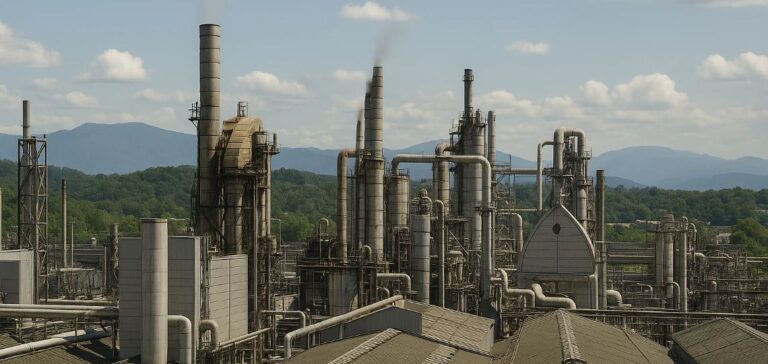The global energy and industrial sector is undergoing a major transformation as the pressure to meet increasingly ambitious climate goals pushes for a rethinking of CO2 emissions management methods. Among the emerging technologies, Carbon Capture, Utilization, and Storage (CCU) is emerging as a strategic lever that both reduces greenhouse gas emissions and supports industrial growth in key sectors such as cement, steel, and chemicals production. A report recently published by the Oxford Institute for Energy Studies (OIES) provides a detailed overview of current and emerging CCU pathways, examining economic opportunities and challenges to be overcome.
CCU: A Circular Solution for Industry
Carbon Capture, Utilization, and Storage (CCU) is based on the idea of capturing carbon dioxide (CO2) emitted by industries and converting it into a useful product or using it in industrial processes. Unlike carbon sequestration (CCS), which involves permanently storing CO2, CCU seeks to reuse it, creating a circular loop of reintegrating carbon into the economic cycle.
While CCU is still in its maturation phase, it is increasingly recognized as a crucial component of the global strategy to reduce greenhouse gas emissions. For example, the construction materials sector employs technologies that inject CO2 into concrete, increasing its strength while capturing carbon over the long term. Furthermore, converting CO2 into biochar or synthetic fuels (e-fuels) is another promising pathway, not only to reduce emissions but also to create new markets.
Mature Technologies and Their Current Applications
Today, the most mature applications of CCU primarily include the use of CO2 in the production of urea and other chemicals. The oil extraction enhancement sector, using CO2 to stimulate hydrocarbon production in depleted reservoirs (Enhanced Oil Recovery, EOR), is also a significant market, although controversial due to the additional emissions associated with the combustion of the oil extracted.
Urea, which accounts for nearly 57% of current CO2 utilization, is primarily used in fertilizer manufacturing. However, this process does not involve permanent carbon storage, as CO2 is typically released into the atmosphere after use. While this pathway is considered mature, it does not provide a long-term solution to achieving carbon neutrality. The volumes of CO2 involved are significant, but the impact on global emissions reduction remains limited as no long-term storage mechanism is put in place.
New CCU Pathways: Biochar, Building Materials, and E-Fuels
Biochar and Agriculture: An Effective Lever for Capturing Carbon
Biochar is a product derived from CO2 that is gaining popularity in the agricultural sector. Produced by high-temperature pyrolysis of biomass, biochar can be used to improve soil structure, increase agricultural yields, and simultaneously store carbon in a stable form for decades or even centuries. When used as a soil amendment, biochar provides a low-cost and highly scalable solution for carbon sequestration. Estimates suggest that biochar could reduce global CO2 emissions by up to 2.2 GtCO2 annually.
Additionally, biochar has the advantage of being produced from locally available biomass, making it a solution adaptable in many regions of the world. Using biochar in soils helps stabilize carbon from decaying organic matter that would otherwise be released into the atmosphere as CO2.
Building Materials: Reducing Emissions in the Cement Sector
The construction sector, particularly concrete production, is responsible for about 8% of global CO2 emissions. However, one emerging solution is to inject CO2 into concrete during its production, which not only permanently stores CO2 but also improves the physical properties of the concrete, such as its strength. This method could reduce emissions associated with concrete production by 30 to 40%, representing a massive decarbonization potential for the industry.
Companies are already experimenting with processes to mineralize CO2 in construction materials, particularly in countries where the demand for concrete is high, such as the United States, China, and India. The development of technologies that allow CO2 captured to be injected into facilities near concrete production could generate significant economies of scale.
E-Fuels: Toward More Sustainable Synthetic Fuels
E-fuels, or synthetic fuels, are another important pathway in the use of CO2. These fuels are produced by converting captured CO2 with renewable hydrogen, creating fuels like methanol or ethanol, which can be used in combustion engines. While this technology is still in development, e-fuels have the advantage of being compatible with existing transport infrastructure, especially in sectors such as aviation and maritime transport, where alternatives are more difficult to deploy.
However, e-fuel production requires a substantial amount of energy, and the current production costs are still very high, up to three times more expensive than traditional fossil fuels. Incentive policies, such as subsidies or carbon credits, could help reduce these costs as the technologies develop and commercialize.
Challenges to Overcome for Large-Scale Adoption of CCU
Despite the promising outlook, CCU faces several major challenges that hinder its large-scale adoption. The first of these is the high cost of current technologies, particularly those related to CO2 capture and its conversion into useful products. The competitiveness of e-fuels, for example, will largely depend on reducing the costs of renewable hydrogen production and renewable electricity.
Moreover, the availability of captured CO2 and the infrastructure needed for its transport present a major obstacle for many CCU applications. The development of pipeline networks and CO2 storage or utilization hubs will be crucial to allow companies to decarbonize their processes at lower costs.
Regulations and Public Policies: A Key Role in Supporting CCU
Public policies will play a decisive role in the development of the CCU market. The implementation of carbon taxes or carbon credit systems could encourage industries to adopt these technologies more proactively. Some regions, such as the European Union or California, have already implemented carbon pricing mechanisms that could promote the deployment of CCU technologies. The introduction of minimum CO2 content standards for certain sectors, such as construction, could also stimulate demand for decarbonized products.
The Future of CCU: Market Prospects and Opportunities
As CCU technologies mature, the market for CO2-derived products is expected to grow significantly, especially in agriculture, building materials, and synthetic fuels sectors. The market for CO2-derived chemicals, for example, could reach up to $40 billion by 2045, with an annual reduction in emissions of 12,000 MtCO2. However, for CCU to reach its full potential, global coordination will be necessary, with alignment of policies, investments in infrastructure, and research efforts to improve technology efficiency.






















